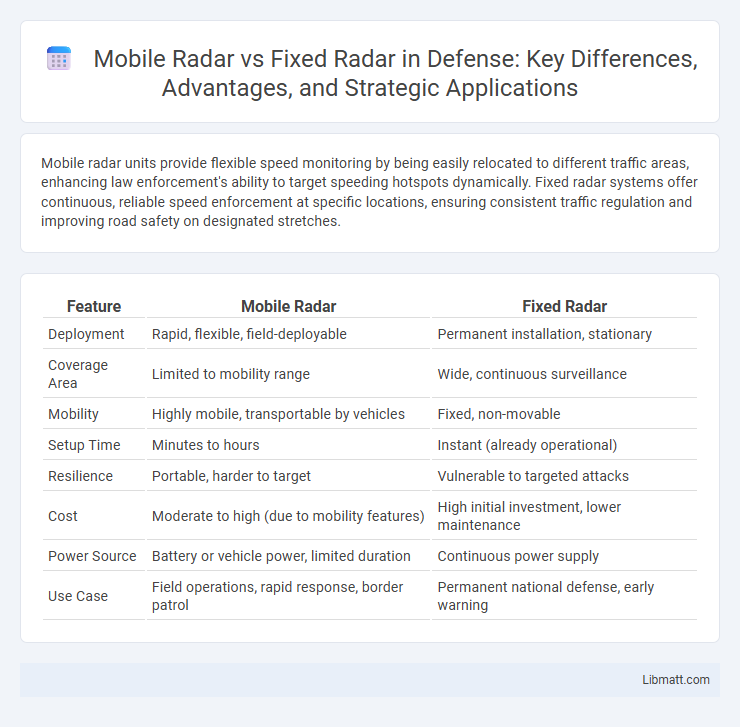Mobile radar units provide flexible speed monitoring by being easily relocated to different traffic areas, enhancing law enforcement's ability to target speeding hotspots dynamically. Fixed radar systems offer continuous, reliable speed enforcement at specific locations, ensuring consistent traffic regulation and improving road safety on designated stretches.
Table of Comparison
| Feature | Mobile Radar | Fixed Radar |
|---|---|---|
| Deployment | Rapid, flexible, field-deployable | Permanent installation, stationary |
| Coverage Area | Limited to mobility range | Wide, continuous surveillance |
| Mobility | Highly mobile, transportable by vehicles | Fixed, non-movable |
| Setup Time | Minutes to hours | Instant (already operational) |
| Resilience | Portable, harder to target | Vulnerable to targeted attacks |
| Cost | Moderate to high (due to mobility features) | High initial investment, lower maintenance |
| Power Source | Battery or vehicle power, limited duration | Continuous power supply |
| Use Case | Field operations, rapid response, border patrol | Permanent national defense, early warning |
Introduction to Mobile and Fixed Radar Systems
Mobile radar systems offer flexibility in deployment and can be relocated to monitor different traffic areas, providing dynamic law enforcement capabilities. Fixed radar systems are permanently installed at specific locations, often integrated with traffic signals or signage to provide constant speed enforcement in high-traffic or accident-prone zones. Both systems utilize radio waves to detect and measure vehicle speed but differ in mobility, coverage consistency, and strategic application in traffic management.
Key Differences Between Mobile and Fixed Radar
Mobile radar units offer flexibility in deployment and can be positioned strategically based on traffic patterns, while fixed radar systems provide constant monitoring at specific locations. Fixed radar is generally more powerful with continuous operation, ensuring consistent speed enforcement, whereas mobile radar allows law enforcement to adapt quickly to varying enforcement needs. Your choice between the two depends on whether you prioritize targeted, variable enforcement or permanent, high-visibility speed control.
Advantages of Mobile Radar Technology
Mobile radar technology offers enhanced flexibility and rapid deployment, allowing law enforcement to monitor traffic in diverse locations without permanent infrastructure. Its ability to be repositioned quickly helps cover more areas and reduces predictability, increasing the effectiveness of speed enforcement. You benefit from improved coverage and adaptability compared to fixed radar systems, which are limited to specific, unchanging sites.
Benefits of Fixed Radar Installations
Fixed radar installations provide continuous and reliable speed monitoring at critical locations, enhancing traffic safety by deterring speeding consistently. Their permanent positioning allows for comprehensive data collection, supporting long-term traffic analysis and law enforcement planning. You benefit from improved road safety and efficient resource allocation due to the steady presence of fixed radar systems.
Limitations of Mobile Radar Units
Mobile radar units face limitations such as reduced detection range compared to fixed radar systems due to size and power constraints. The mobility of these units can lead to less stable positioning, affecting accuracy and consistent data collection. Your ability to monitor long-range or continuous traffic patterns may be compromised when relying solely on mobile radar technology.
Challenges Faced by Fixed Radar Systems
Fixed radar systems face challenges such as limited coverage areas restricted to specific locations and vulnerability to terrain obstructions, leading to blind spots in detection. They often require significant infrastructure investment and maintenance, which can limit deployment flexibility in diverse environments. Fixed radars may also struggle with adapting to dynamic traffic patterns or rapidly changing weather conditions compared to mobile radar systems.
Use Cases for Mobile Radar Applications
Mobile radar systems offer versatile applications in traffic enforcement by enabling law enforcement to monitor speed violations in varying locations, including construction zones, school areas, and accident-prone stretches. They are effective for temporary deployments during special events or road maintenance, where fixed radar infrastructure is unavailable or impractical. These adaptable use cases enhance traffic safety and enforcement flexibility, addressing dynamic monitoring needs beyond the static coverage of fixed radar units.
Common Environments for Fixed Radar Deployment
Fixed radar systems are commonly deployed along highways, urban intersections, and toll plazas to monitor traffic speed and enhance road safety continuously. These radars are strategically installed on poles, traffic signals, or gantries to provide constant surveillance in high-traffic and accident-prone areas. Their stationary nature allows for precise, long-term data collection, supporting efficient law enforcement and traffic management efforts.
Mobility, Flexibility, and Rapid Deployment
Mobile radar systems offer unparalleled mobility and rapid deployment capabilities, allowing law enforcement to quickly position equipment in high-traffic or accident-prone areas. Unlike fixed radar units, mobile radars provide greater flexibility to adapt to changing traffic patterns and enforcement needs, supporting dynamic speed monitoring strategies. Their portability enables swift relocation, enhancing coverage and deterrence effectiveness across diverse road environments.
Cost, Maintenance, and Scalability Comparison
Mobile radar systems typically incur higher initial costs due to their advanced mobility features but offer lower long-term maintenance expenses compared to fixed radar installations, which require regular site upkeep. Fixed radar units present scalability challenges as expanding coverage demands additional stationary units and infrastructure investments, whereas mobile radars provide flexible deployment options, allowing you to adjust coverage dynamically without significant infrastructure costs. Maintenance for mobile radar is often more streamlined, relying on portable diagnostics, while fixed radar systems may require specialized on-site technicians and resources, impacting overall operational efficiency.
mobile radar vs fixed radar Infographic

 libmatt.com
libmatt.com